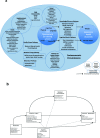Impact of child development at primary school entry on adolescent health-protocol for a participatory systematic review
- PMID: 33962672
- PMCID: PMC8105931
- DOI: 10.1186/s13643-021-01694-6
Impact of child development at primary school entry on adolescent health-protocol for a participatory systematic review
Abstract
Background: Reducing child health inequalities is a global health priority and evidence suggests that optimal development of knowledge, skills and attributes in early childhood could reduce health risks across the life course. Despite a strong policy rhetoric on giving children the 'best start in life', socioeconomic inequalities in children's development when they start school persist. So too do inequalities in child and adolescent health. These in turn influence health inequalities in adulthood. Understanding how developmental processes affect health in the context of socioeconomic factors as children age could inform a holistic policy approach to health and development from childhood through to adolescence. However, the relationship between child development and early adolescent health consequences is poorly understood. Therefore the aim of this review is to summarise evidence on the associations between child development at primary school starting age (3-7 years) and subsequent health in adolescence (8-15 years) and the factors that mediate or moderate this relationship.
Method: A participatory systematic review method will be used. The search strategy will include; searches of electronic databases (MEDLINE, PsycINFO, ASSIA and ERIC) from November 1990 onwards, grey literature, reference searches and discussions with stakeholders. Articles will be screened using inclusion and exclusion criteria at title and abstract level, and at full article level. Observational, intervention and review studies reporting a measure of child development at the age of starting school and health outcomes in early adolescence, from a member country of the Organisation for Economic Co-operation and Development, will be included. The primary outcome will be health and wellbeing outcomes (such as weight, mental health, socio-emotional behaviour, dietary habits). Secondary outcomes will include educational outcomes. Studies will be assessed for quality using appropriate tools. A conceptual model, produced with stakeholders at the outset of the study, will act as a framework for extracting and analysing evidence. The model will be refined through analysis of the included literature. Narrative synthesis will be used to generate findings and produce a diagram of the relationship between child development and adolescent health.
Discussion: The review will elucidate how children's development at the age of starting school is related to subsequent health outcomes in contexts of socioeconomic inequality. This will inform ways to intervene to improve health and reduce health inequality in adolescents. The findings will generate knowledge of cross-sector relevance for health and education and promote inter-sectoral coherence in addressing health inequalities throughout childhood.
Protocol registration: This systematic review protocol has been registered with PROSPERO CRD42020210011 .
Keywords: Adolescent health; Child development; Inequality; Primary School; Public health.
Conflict of interest statement
The authors declare they have no competing interests.
Figures

Similar articles
-
Tackling inequalities in obesity: a protocol for a systematic review of the effectiveness of public health interventions at reducing socioeconomic inequalities in obesity amongst children.Syst Rev. 2012 Feb 23;1:16. doi: 10.1186/2046-4053-1-16. Syst Rev. 2012. PMID: 22587775 Free PMC article.
-
Effective educational interventions for the promotion of sexual and reproductive health and rights for school-age children in low- and middle-income countries: a systematic review protocol.Syst Rev. 2020 Sep 18;9(1):216. doi: 10.1186/s13643-020-01464-w. Syst Rev. 2020. PMID: 32948251 Free PMC article.
-
Nature-based early childhood education for child health, wellbeing and development: a mixed-methods systematic review protocol.Syst Rev. 2020 Oct 2;9(1):226. doi: 10.1186/s13643-020-01489-1. Syst Rev. 2020. PMID: 33008489 Free PMC article.
-
Socioeconomic inequalities and the equity impact of population-level interventions for adolescent health: an overview of systematic reviews.Public Health. 2020 Mar;180:154-162. doi: 10.1016/j.puhe.2019.11.008. Epub 2020 Jan 7. Public Health. 2020. PMID: 31923881 Review.
-
The Impact of Age on Income-Related Health Status Inequalities from Birth to Adolescence: A Systematic Review with Cross-Country Comparisons.J Pediatr. 2018 Dec;203:380-390.e14. doi: 10.1016/j.jpeds.2018.07.030. Epub 2018 Sep 25. J Pediatr. 2018. PMID: 30266508
Cited by
-
Relationships between Child Development at School Entry and Adolescent Health-A Participatory Systematic Review.Int J Environ Res Public Health. 2021 Nov 4;18(21):11613. doi: 10.3390/ijerph182111613. Int J Environ Res Public Health. 2021. PMID: 34770127 Free PMC article.
References
-
- Irwin L, Siddiqi A, Hertzman C, WHO Commision on Social Determinants of Health. Early Child Development: A powerful equalizer. 2007.
Publication types
MeSH terms
Grants and funding
LinkOut - more resources
Full Text Sources
Other Literature Sources
Medical

